Numerical Modeling of the Shape of Agricultural Products on the Example of Cucumber Fruits
Abstract
:1. Introduction
2. Materials and Methods
- ellipsoid model (M1):where:and where F(Θ,m) and E(Θ,m) are incomplete elliptic integrals of the first and second kind [37].
- spheroid model (M2), when: , then:where:cylinder model (M3):
- model combining a truncated cone and two hemispheres (M4)
- model combining a cylinder and two hemispheres (M5)
- model combining two truncated cones and two hemispheres (M6)
3. Results and Discussion
4. Conclusions
- Geometric models and direct measurements of the geometric parameters of agricultural products facilitate the planning of spraying, sorting and packaging operations. These methods enable small-scale farmers to easily determine the geometric parameters (volume, surface area) of raw materials without the use of expensive and sophisticated devices such as 3D scanners. Direct measurements of the geometric parameters of agricultural raw materials are consistent with sustainable development principles and can be applied on a large scale.
- Models where the relative error of measurement does not exceed 5% are recommended when the surface area of cucumbers is calculated with an electronic caliper and mathematical formulas of the presented geometric models. The above condition was fulfilled by the spheroid model (M2) and the model combining two truncated cones and two hemispheres with different diameters (M6). Relative error was higher in the range of 8% to 12% when the surface area of cucumbers was determined with the ellipsoid model (M1), the model combining a truncated cone and two hemispheres (M4) and the model combining a cylinder and two hemispheres (M5). The surface area of cucumbers should not be calculated with the cylinder model (M3) where relative error reached 35%.
- The volume of fruits can be calculated with the use of the ellipsoid model (M1), the spheroid model (M2) and, similarly to surface area measurements, the model combining two truncated cones and two hemispheres with different diameters (M6). The relative error of the above geometric models did not exceed 5.5%. Relative error was higher in the range of 14% to 16% when cucumber volume was determined with the model combining a truncated cone and two hemispheres (M4) and the model combining a cylinder and two hemispheres (M5). The relative error of the cylinder model (M3) was determined at 54%.
- The significance of differences between the mean values of surface area was determined in the Kruskal-Wallis test, and no significant differences were observed in models M1, M2, M4 and M5. However, models M1, M4 and M5 cannot be used to determine the surface area of cucumber fruit due to high mean relative error at 8.37%, 9.98% and 11.44%, respectively.
- In the literature, the mathematical formula for calculating the volume of an ellipsoid (M1) is often used to determine the volume of agricultural products with an ellipsoidal shape. Relative error is estimated at 3% when the volume of ellipsoidal fruits is calculated with the above mathematical formula.
- In the group of the evaluated methods for determining the geometric parameters of agricultural materials, 3D scanning is the most informative approach. Numerical models support the determination of a full range of geometric parameters (dimensions, area, volume) of entire objects and their fragments. The shape of the analyzed object is stored in computer memory as a cloud of points, and can be used to measure volume without the involvement of displacement methods where the sample is immersed in liquid. Numerical models can also be archived and used for future research.
- The measurable result of the study was the development of models supporting the determination of the geometric parameters (surface area, volume) of agricultural materials based on their basic dimensions (length, width, thickness). In most cases, the proposed models support the determination of the above geometric parameters with a relative error below 5% within a short period time. Therefore, they can be used in the research and design of new cucumber processing equipment.
- Further research should focus on the development of models of agricultural raw materials that facilitate the determination of geometric parameters for planning and performing of production processes in agriculture.
Author Contributions
Funding
Conflicts of Interest
References
- Datta, A.K.; Halder, A. Status of food process modeling and where do we go from here (synthesis of the outcome from brainstorming). Compr. Rev. Food Sci. Food Saf. 2008, 7, 117–120. [Google Scholar] [CrossRef]
- Verboven, P.; De Baerdemaeker, J.; Nicolai, B.M. Using computational fluid dynamics to optimize thermal processes. In Improving the Thermal Processing of Foods; Richardson, P., Ed.; CRC Press: Boca Raton, FL, USA, 2004; pp. 82–102. [Google Scholar]
- Goni, S.M.; Purlis, E.; Salvadori, V.O. Three-dimensional reconstruction of irregular foodstuffs. J. Food Eng. 2007, 82, 536–547. [Google Scholar] [CrossRef]
- Frączek, J.; Wróbel, M. Methodic aspects of seed shape assessment. Inżynieria Rolnicza 2006, 12, 155–163. (In Polish) [Google Scholar]
- Szwedziak, K.; Rut, J. Assessment of pollutants of the grain corn with the help of computer analysis of the image. Postępy Techniki Przetwórstwa Spożywczego 2008, 1, 14–15. (In Polish) [Google Scholar]
- Deshpande, S.D.; Bal, S.; Ojha, T.P. Physical properties of soybean. J. Agric. Eng. Res. 1993, 56, 89–98. [Google Scholar] [CrossRef]
- Gupta, R.K.; Das, S.K. Physical properties of Sunflower seeds. J. Agric. Eng. Res. 1997, 66, 1–8. [Google Scholar] [CrossRef]
- Cahsir, S.; Marakoglu, T.; Ogut, H.; Ozturk, O. Physical properties of rapeseed (Brassica napus oleifera L.). J. Food Eng. 2005, 69, 61–66. [Google Scholar]
- Tańska, M.; Rotkiewicz, D.; Kozirok, W.; Konopka, I. Measurement of the geometrical features and surface color of rapeseeds using digital image analysis. Food Res. Int. 2005, 38, 741–750. [Google Scholar] [CrossRef]
- Jadwisieńczak, K.; Kaliniewicz, Z. Analysis of the mustard seeds cleaning process. Part 1. Physical properties of seeds. Inżynieria Rolnicza 2011, 9, 57–64. (In Polish) [Google Scholar]
- Coskuner, Y.; Karababa, E. Some physical properties of flaxseed (Linum usitatissimum L.). J. Food Eng. 2007, 78, 1067–1073. [Google Scholar] [CrossRef]
- Erdogdu, F.; Balaban, M.O.; Chau, K.V. Modeling of heat conduction in elliptical cross-section: II, Adaptation to thermal processing of shrimp. J. Food Eng. 1998, 38, 241–258. [Google Scholar] [CrossRef]
- Luzuriaga, D.A.; Balaban, M.O.; Yeralan, S. Analysis of visual quality attributes of white shrimp by machine vision. J. Food Sci. 1997, 62, 113–118. [Google Scholar] [CrossRef]
- Crocombe, J.P.; Lovatt, S.J.; Clarke, R.D. Evaluation of chilling time shape factors through the use of three-dimensional surface modeling. In Proceedings of the 20th International Congress of Refrigeration 1999: IIR/IIF, Sydney, Australia, 19–24 September 1999; p. 353. [Google Scholar]
- Jancsok, P.T.; Clijmans, L.; Nicolai, B.M.; De Baerdemaeker, J. Investigation of the effect of shape on the acoustic response of ‘conference’ pears by finite element modeling. Postharvest Biol. Technol. 2001, 23, 1–12. [Google Scholar] [CrossRef]
- Borsa, J.; Chu, R.; Sun, J.; Linton, N.; Hunter, C. Use of CT scans and treatment planning software for validation of the dose component of food irradiation protocols. Radiat. Phys. Chem. 2002, 63, 271–275. [Google Scholar] [CrossRef]
- Sabliov, C.M.; Bolder, D.; Keener, K.M.; Farkas, B.E. Image processing method to determine surface area and volume of axi-symmetric agricultural products. Int. J. Food Prop. 2002, 5, 641–653. [Google Scholar] [CrossRef]
- Zapotoczny, P. Measuring geometrical parameters of cucumbers fruits using computer image analysis. Problemy Inżynierii Rolniczej 2002, 4, 57–64. (In Polish) [Google Scholar]
- Scheerlinck, N.; Marquenie, D.; Jancsok, P.T.; Verboven, P.; Moles, C.G.; Banga, J.R.; Nicolai, B.M. A model-based approach to develop periodic thermal treatments for surface decontamination of strawberries. Postharvest Biol. Technol. 2004, 34, 39–52. [Google Scholar] [CrossRef]
- Du, C.; Sun, D.W. Estimating the surface area and volume of ellipsoidal ham using computer vision. J. Food Eng. 2006, 73, 260–268. [Google Scholar] [CrossRef]
- Zheng, C.; Sun, D.W.; Du, C.J. Estimating shrinkage of large cooked beef joints during air-blast cooling by computer vision. J. Food Eng. 2006, 72, 56–62. [Google Scholar] [CrossRef]
- Kim, J.; Moreira, R.G.; Huang, Y.; Castell-Perez, M.E. 3-D dose distributions for optimum radiation treatment planning of complex foods. J. Food Eng. 2007, 79, 312–321. [Google Scholar] [CrossRef]
- Goni, S.M.; Purlis, E.; Salvadori, V.O. Geometry modeling of food materials from magnetic resonance imaging. J. Food Eng. 2008, 88, 561–567. [Google Scholar] [CrossRef]
- Siripon, K.; Tansakul, A.; Mittal, G.S. Heat transfer modeling of chicken cooking in hot water. Food Res. Int. 2007, 40, 923–930. [Google Scholar] [CrossRef]
- Mieszkalski, L. Computer-aiding of mathematical modeling of the carrot (Daucus carota L.) root shape. Ann. Wars. Univ. Life Sci. SGGW Agric. 2013, 61, 17–23. [Google Scholar]
- Mieszkalski, L. Bezier curves in modeling the shapes of biological objects. Ann. Wars. Univ. Life Sci. SGGW Agric. 2014, 64, 117–128. [Google Scholar]
- Balcerzak, K.; Weres, J.; Górna, K.; Idziaszek, P. Modeling of agri-food products on the basis of solid geometry with examples in AutoDesk 3ds Max and finite element mesh generation. J. Res. Appl. Agric. Eng. 2015, 60, 5–8. [Google Scholar]
- Ho, Q.T.; Carmeliet, J.; Datta, A.K.; Defraeye, T.; Delele, M.A.; Herremans, E.; Opara, L.; Ramon, H.; Tijskens, E.; Sman, R.; et al. Multiscale modeling in food engineering. J. Food Eng. 2013, 114, 279–291. [Google Scholar] [CrossRef]
- Anders, A. Determination of the Geometric Parameters of Seeds with Different Methods; Wydawnictwo Uniwersytetu Warmińsko-Mazurskiego w Olsztynie: Olsztyn, Poland, 2019; ISBN 978-83-8100-163-2. (In Polish) [Google Scholar]
- Rahmi, U.; Ferruh, E. Potential use of 3-dimensional scanners for food process modeling. J. Food Eng. 2009, 93, 337–343. [Google Scholar]
- Anders, A.; Markowski, P.; Kaliniewicz, Z. Numerical modelling of agricultural products on the example of bean and yellow lupine seeds. Int. Agrophys. 2015, 29, 397–403. [Google Scholar] [CrossRef] [Green Version]
- Anders, A.; Markowski, P.; Kaliniewicz, Z. Evaluation of geometric and physical properties of chosen pear cultivars based on numerical models obtained by a 3D scanner. Zeszyty Problemowe Postępów Nauk Rolniczych 2014, 577, 3–12. (In Polish) [Google Scholar]
- Anders, A.; Markowski, P.; Kaliniewicz, Z. The application of a 3D scanner for the evaluation of geometric properties of Cannabis sativa L. seeds. Acta Agrophys. 2014, 21, 391–402. (In Polish) [Google Scholar]
- NextEngine User Manual. 2010. Available online: http://www.nextengine.com (accessed on 1 July 2018).
- MeshLab Visual Computing Lab—ISTI—CNR. 2013. Available online: http://meshlab.sourceforge.net (accessed on 1 July 2018).
- Gastón, A.L.; Abalone, R.M.; Giner, S.A. Wheat drying kinetics. Diffusivities for sphere and ellipsoid by finite elements. J. Food Eng. 2002, 52, 313–322. [Google Scholar] [CrossRef]
- Bronsztejn, I.N.; Siemiendiajew, K.A.; Musiol, G.; Muhling, H. Nowoczesne Kompendium Matematyki; PWN: Warszawa, Poland, 2009. (In Polish) [Google Scholar]
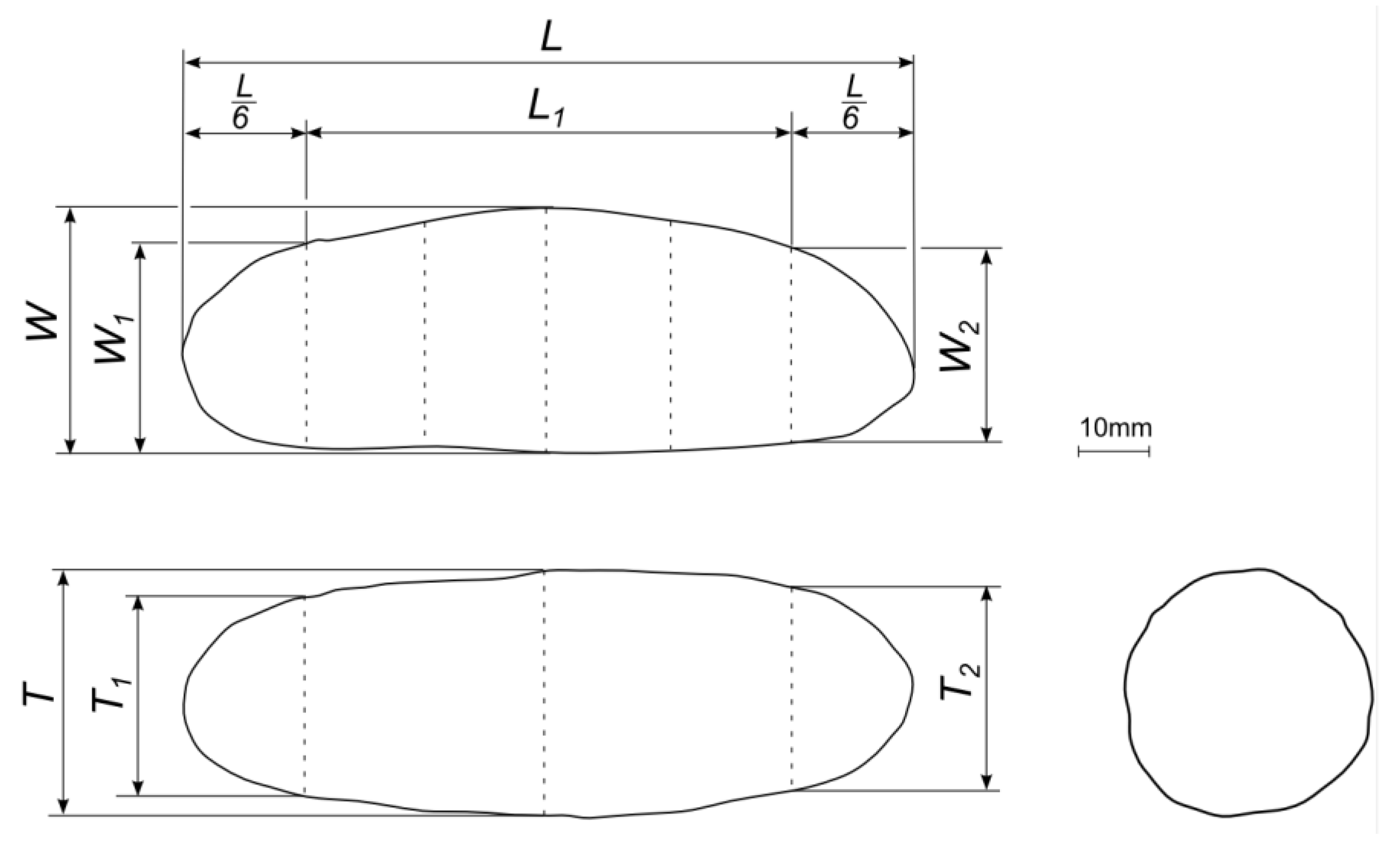
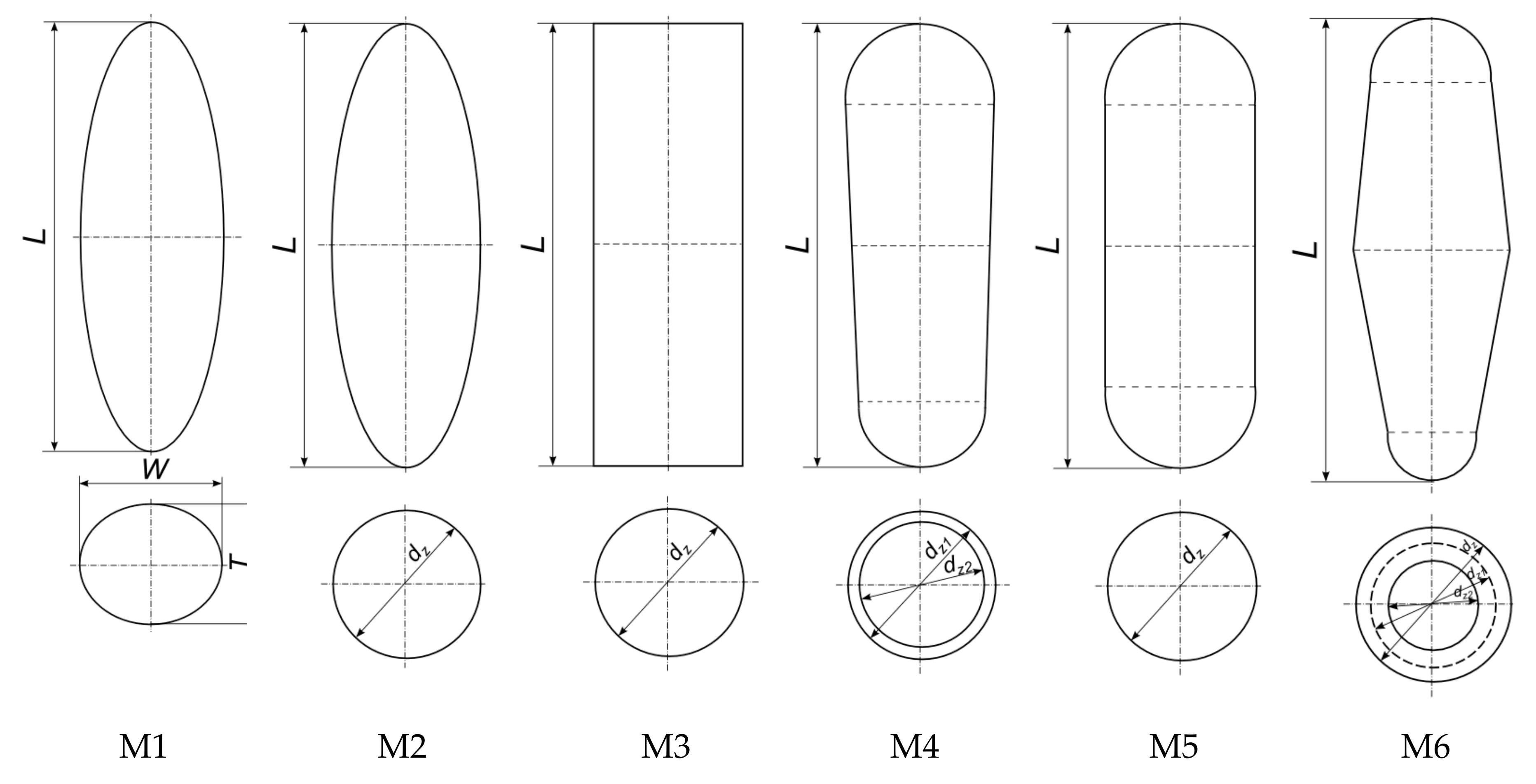
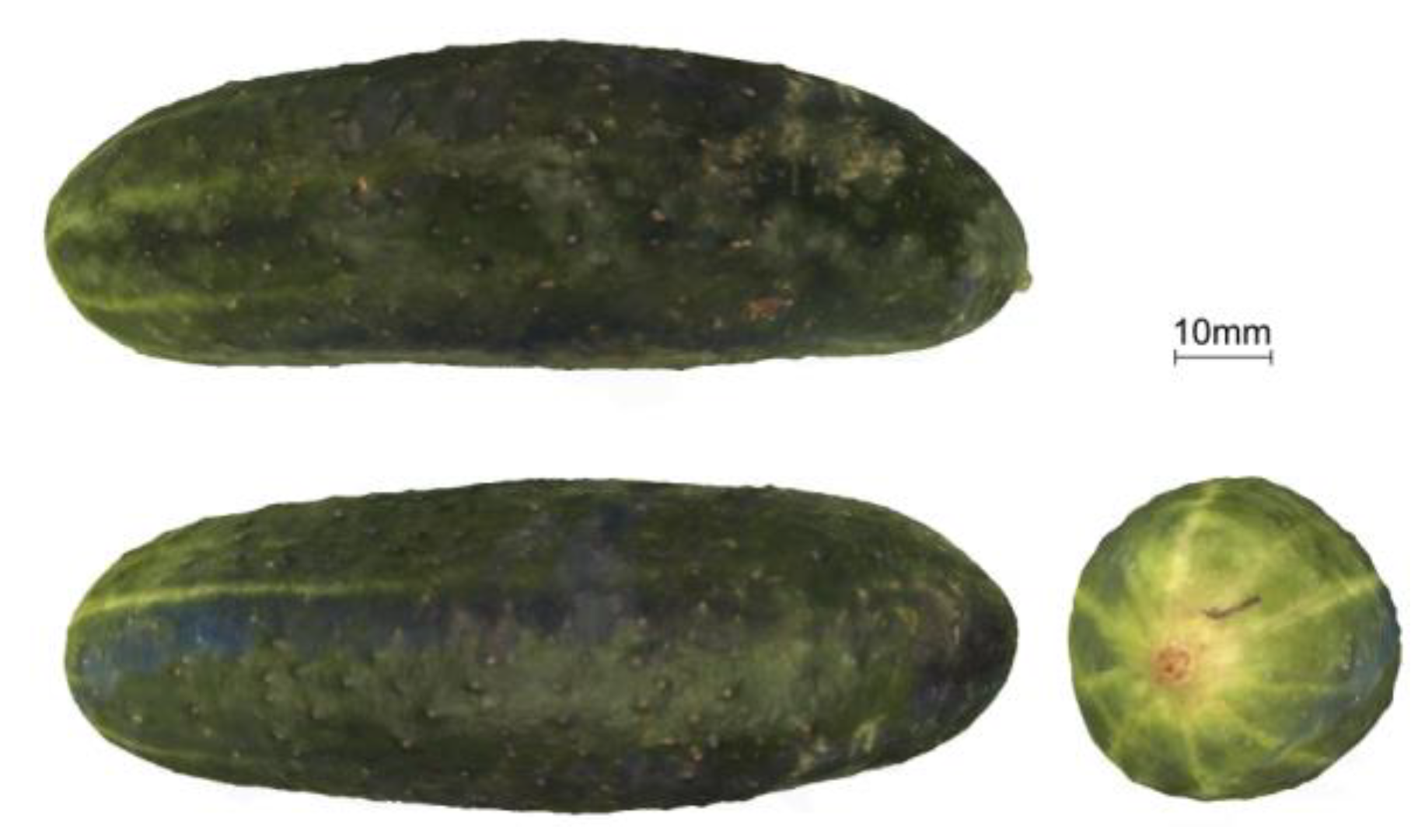
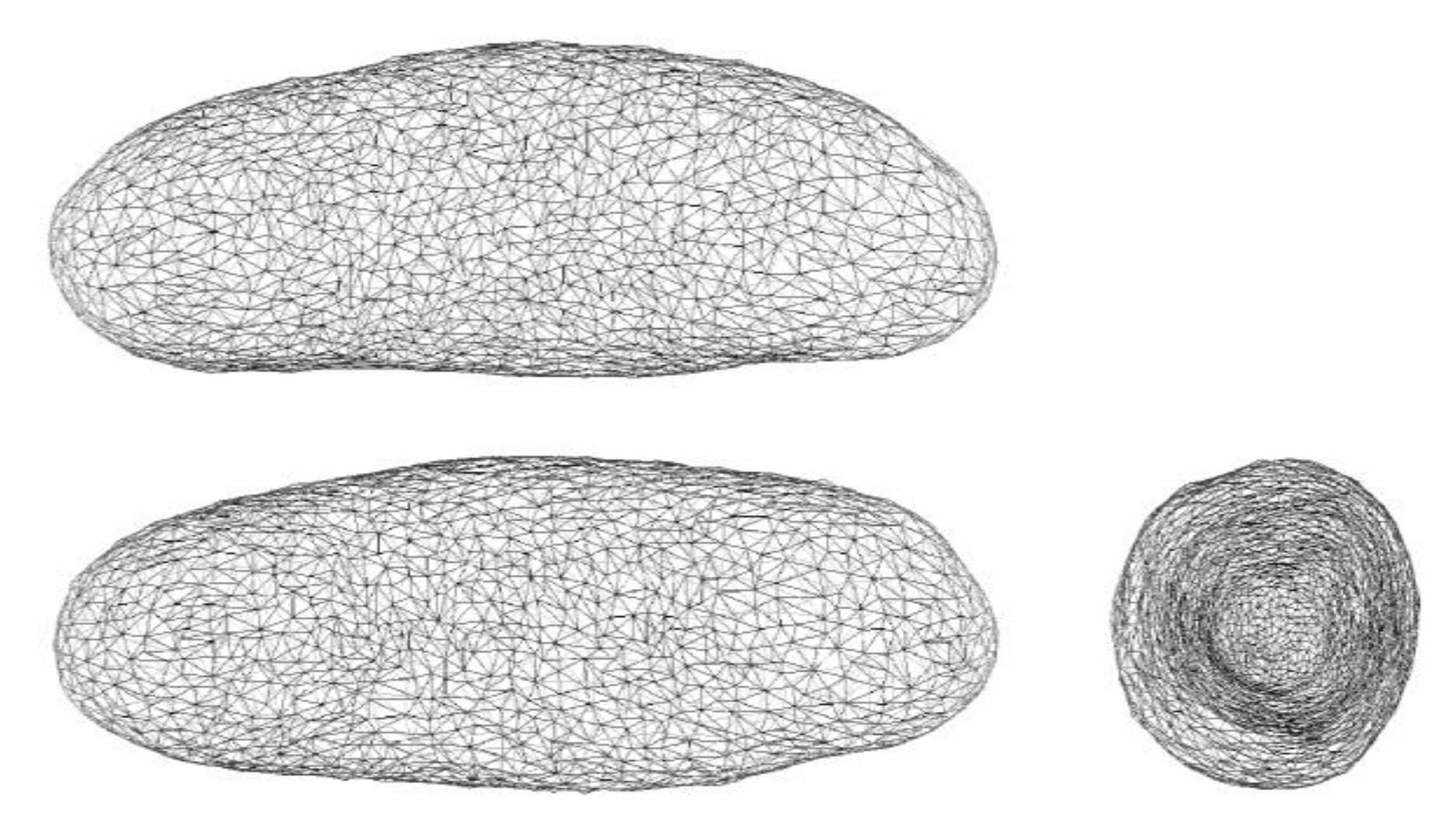
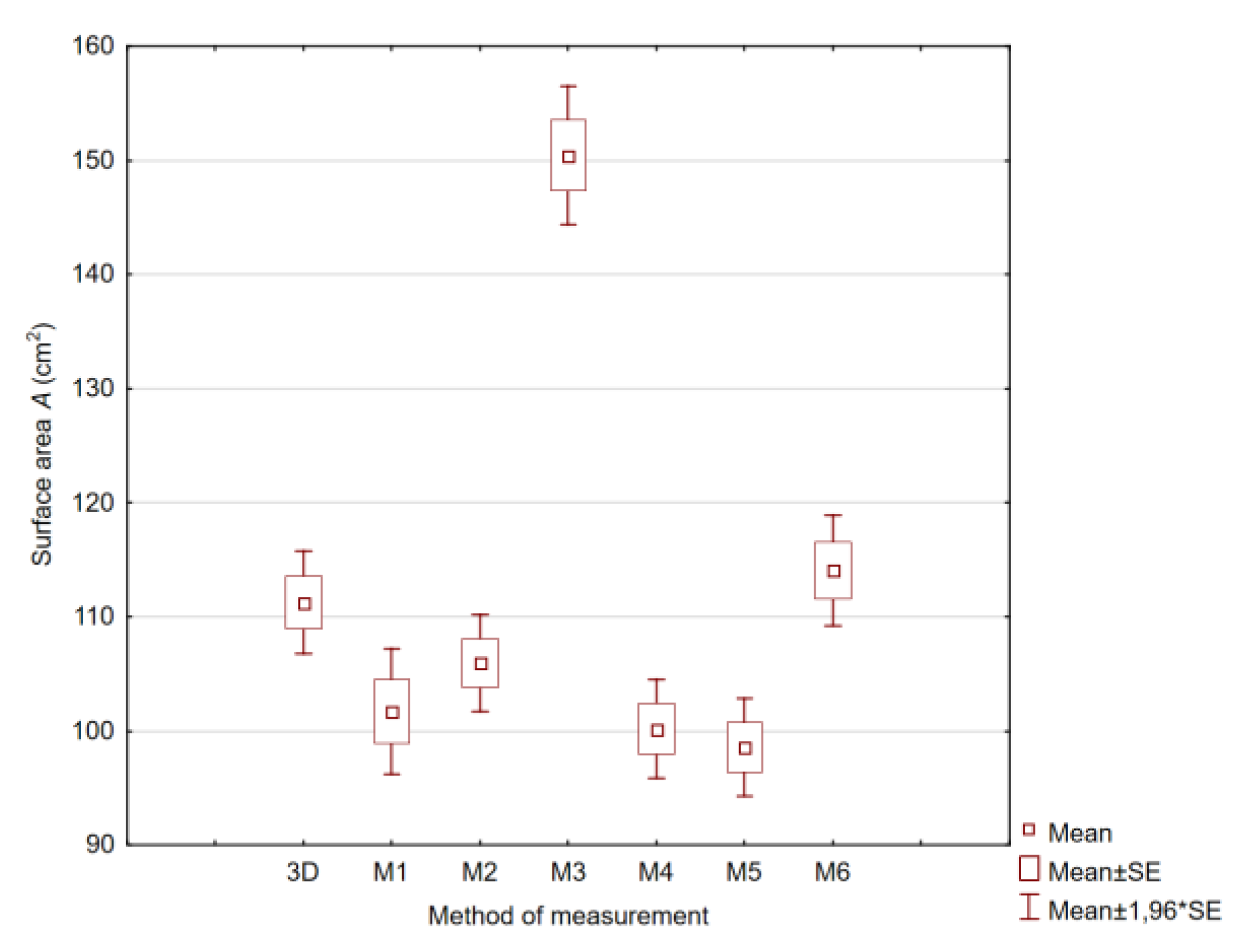

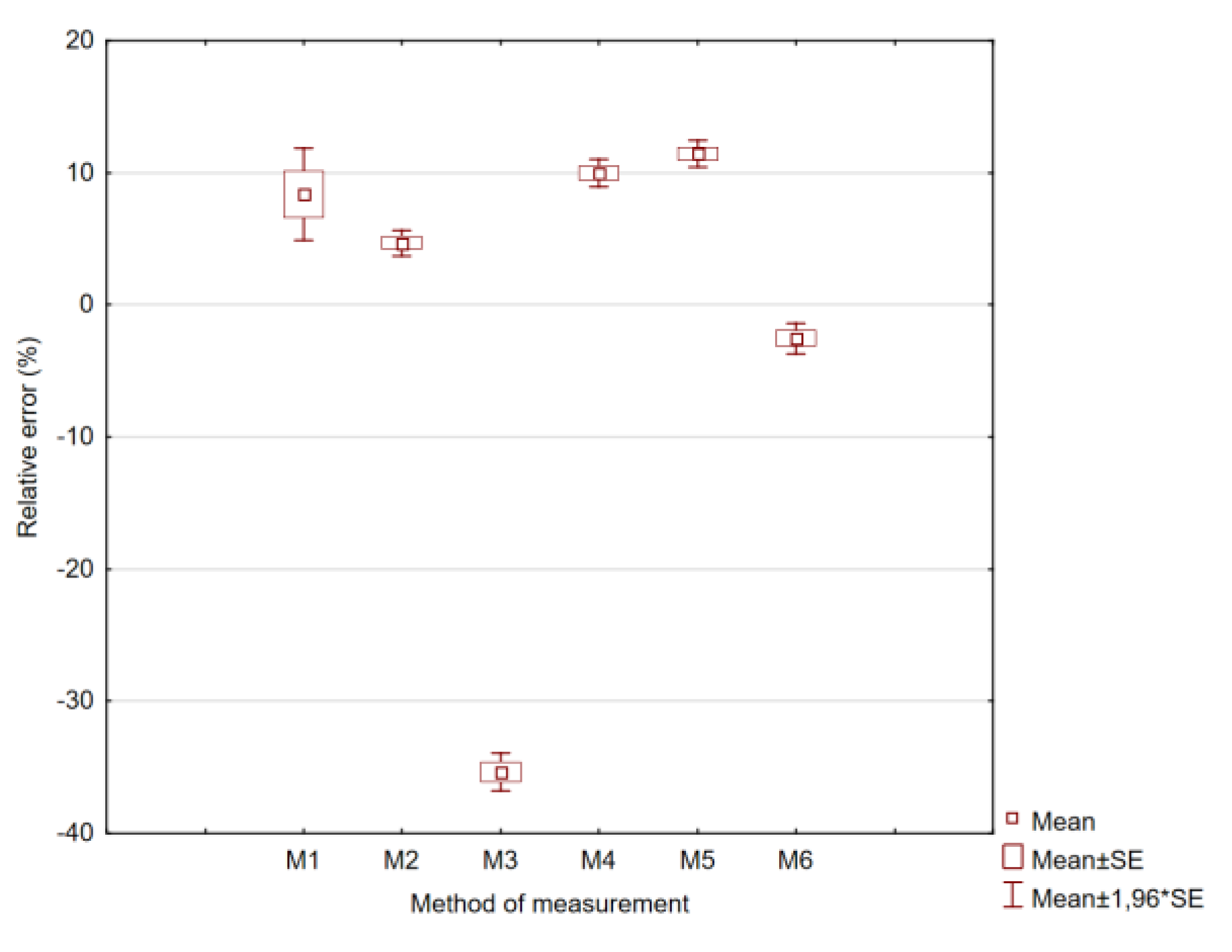
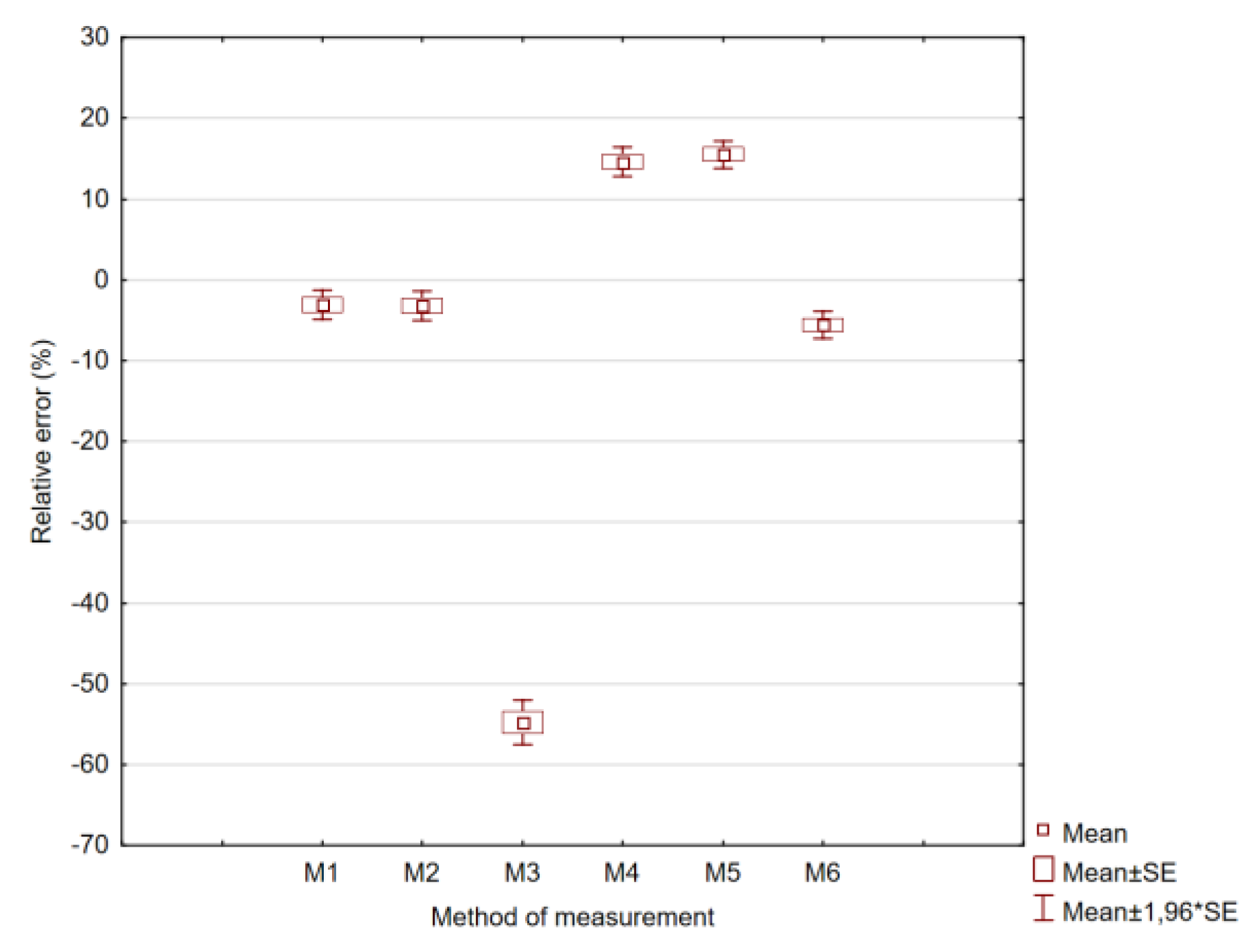
| Variable1 | Mean | Range | Standard Deviation |
|---|---|---|---|
| L (mm) | 113.14 | 39.10 | 9.94 |
| W (mm) | 37.23 | 13.04 | 3.28 |
| T (mm) | 35.47 | 14.82 | 3.31 |
| A 3D (mm2) | 111.25 | 70.54 | 16.12 |
| V 3D (mm3) | 77.26 | 80.73 | 18.89 |
| 3D-3D scan | |||
| Surface Area A (Kruskal-Wallis Test) H(6, N = 350) = 132.2065; p = 0.000 | ||||
|---|---|---|---|---|
| Probability of Multiple Comparisons | ||||
| Measurement Method | Number of Observations N | Rank Sum | Mean Rank | Mean |
| 3D | 50 | 9288.50 | 185.77 | 111.25 bc |
| M1 | 50 | 6939.50 | 138.79 | 101.71 a |
| M2 | 50 | 7863.00 | 157.26 | 105.93 ab |
| M3 | 50 | 15,564.00 | 311.28 | 150.45 d |
| M4 | 50 | 6181.00 | 123.62 | 100.17a |
| M5 | 50 | 5737.00 | 114.74 | 98.57 a |
| M6 | 50 | 9852.00 | 197.04 | 114.06 c |
| Volume V (Kruskal-Wallis Test) H(6, N = 350) = 124.2550; p = 0.000 | ||||
|---|---|---|---|---|
| Probability of Multiple Comparisons | ||||
| Measurement Method | Number of Observations N | Rank Sum | Mean Rank | Mean |
| 3D | 50 | 8301.00 | 166.02 | 77.26 a |
| M1 | 50 | 8910.00 | 178.20 | 79.21 a |
| M2 | 50 | 8982.00 | 179.64 | 79.29 a |
| M3 | 50 | 15,085.00 | 301.70 | 118.93 c |
| M4 | 50 | 5492.00 | 109.84 | 65.85 b |
| M5 | 50 | 5262.00 | 105.24 | 65.16 b |
| M6 | 50 | 9393.00 | 187.86 | 81.27 a |
© 2019 by the authors. Licensee MDPI, Basel, Switzerland. This article is an open access article distributed under the terms and conditions of the Creative Commons Attribution (CC BY) license (http://creativecommons.org/licenses/by/4.0/).
Share and Cite
Anders, A.; Choszcz, D.; Markowski, P.; Lipiński, A.J.; Kaliniewicz, Z.; Ślesicka, E. Numerical Modeling of the Shape of Agricultural Products on the Example of Cucumber Fruits. Sustainability 2019, 11, 2798. https://doi.org/10.3390/su11102798
Anders A, Choszcz D, Markowski P, Lipiński AJ, Kaliniewicz Z, Ślesicka E. Numerical Modeling of the Shape of Agricultural Products on the Example of Cucumber Fruits. Sustainability. 2019; 11(10):2798. https://doi.org/10.3390/su11102798
Chicago/Turabian StyleAnders, Andrzej, Dariusz Choszcz, Piotr Markowski, Adam Józef Lipiński, Zdzisław Kaliniewicz, and Elwira Ślesicka. 2019. "Numerical Modeling of the Shape of Agricultural Products on the Example of Cucumber Fruits" Sustainability 11, no. 10: 2798. https://doi.org/10.3390/su11102798
APA StyleAnders, A., Choszcz, D., Markowski, P., Lipiński, A. J., Kaliniewicz, Z., & Ślesicka, E. (2019). Numerical Modeling of the Shape of Agricultural Products on the Example of Cucumber Fruits. Sustainability, 11(10), 2798. https://doi.org/10.3390/su11102798





